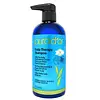What's inside
What's inside
 Key Ingredients
Key Ingredients

 Benefits
Benefits

 Concerns
Concerns

 Ingredients Side-by-side
Ingredients Side-by-side

Aloe Barbadensis Leaf Juice
Skin ConditioningCetyl Hydroxyethylcellulose
Emulsion StabilisingSodium Hydroxide
BufferingKeratin
Skin ConditioningSodium Cocoyl Glutamate
CleansingCocamidopropyl Hydroxysultaine
CleansingPolysorbate 20
EmulsifyingBiotin
AntiseborrhoeicPolyquaternium-73
Cocamide Mipa
EmulsifyingArgania Spinosa Kernel Oil
EmollientMelaleuca Alternifolia Leaf Oil
AntioxidantMentha Piperita Oil
MaskingCitrus Limon Peel Oil
MaskingCedrus Atlantica Bark Oil
MaskingLavandula Angustifolia Oil
MaskingSalvia Sclarea Oil
MaskingPersea Gratissima Oil
Skin ConditioningPogostemon Cablin Leaf Oil
MaskingIsobutylamido Thiazolyl Resorcinol
BleachingRiboflavin
Cosmetic ColorantNiacin
SmoothingPantothenic Acid
Skin ConditioningPyridoxine
Skin ConditioningFolic Acid
Skin ConditioningCyanocobalamin
Skin ConditioningAscorbic Acid
AntioxidantZinc Gluconate
Skin ConditioningTocopherol
AntioxidantCaprylhydroxamic Acid
Caprylyl Glycol
EmollientGlycerin
HumectantCitric Acid
BufferingAloe Barbadensis Leaf Juice, Cetyl Hydroxyethylcellulose, Sodium Hydroxide, Keratin, Sodium Cocoyl Glutamate, Cocamidopropyl Hydroxysultaine, Polysorbate 20, Biotin, Polyquaternium-73, Cocamide Mipa, Argania Spinosa Kernel Oil, Melaleuca Alternifolia Leaf Oil, Mentha Piperita Oil, Citrus Limon Peel Oil, Cedrus Atlantica Bark Oil, Lavandula Angustifolia Oil, Salvia Sclarea Oil, Persea Gratissima Oil, Pogostemon Cablin Leaf Oil, Isobutylamido Thiazolyl Resorcinol, Riboflavin, Niacin, Pantothenic Acid, Pyridoxine, Folic Acid, Cyanocobalamin, Ascorbic Acid, Zinc Gluconate, Tocopherol, Caprylhydroxamic Acid, Caprylyl Glycol, Glycerin, Citric Acid
Water
Skin ConditioningSodium Laureth Sulfate
CleansingSodium Lauryl Sulfate
CleansingCocamidopropyl Betaine
CleansingCocamide Mea
EmulsifyingSodium Benzoate
MaskingCitric Acid
BufferingSodium Chloride
MaskingSalicylic Acid
MaskingMentha Arvensis Leaf Oil
MaskingMentha Piperita Oil
MaskingTetrasodium EDTA
Methylparaben
PreservativePropylene Glycol
HumectantGlycerin
HumectantSodium Hydroxide
BufferingLimonene
PerfumingCamellia Sinensis Leaf Extract
AntimicrobialCystine Bis-Pg-Propyl Silanetriol
Skin ConditioningNiacinamide
SmoothingPanthenol
Skin ConditioningBiotin
AntiseborrhoeicLecithin
EmollientTocopheryl Acetate
AntioxidantCitrus Paradisi Peel Extract
PerfumingHumulus Lupulus Extract
AntimicrobialUrtica Dioica Leaf Extract
Skin ConditioningCI 42090
Cosmetic ColorantAcer Saccharum Extract
Skin ConditioningCitrus Limon Peel Extract
EmollientSaccharum Officinarum Extract
MoisturisingVaccinium Myrtillus Leaf Extract
AstringentFaex Extract
Skin ConditioningPropylparaben
PreservativePhenoxyethanol
PreservativeCitrus Aurantium Dulcis Fruit Extract
MaskingPotassium Sorbate
PreservativeMaltodextrin
AbsorbentSodium Citrate
BufferingEthylparaben
PreservativeButylparaben
MaskingSodium Xylenesulfonate
Water, Sodium Laureth Sulfate, Sodium Lauryl Sulfate, Cocamidopropyl Betaine, Cocamide Mea, Sodium Benzoate, Citric Acid, Sodium Chloride, Salicylic Acid, Mentha Arvensis Leaf Oil, Mentha Piperita Oil, Tetrasodium EDTA, Methylparaben, Propylene Glycol, Glycerin, Sodium Hydroxide, Limonene, Camellia Sinensis Leaf Extract, Cystine Bis-Pg-Propyl Silanetriol, Niacinamide, Panthenol, Biotin, Lecithin, Tocopheryl Acetate, Citrus Paradisi Peel Extract, Humulus Lupulus Extract, Urtica Dioica Leaf Extract, CI 42090, Acer Saccharum Extract, Citrus Limon Peel Extract, Saccharum Officinarum Extract, Vaccinium Myrtillus Leaf Extract, Faex Extract, Propylparaben, Phenoxyethanol, Citrus Aurantium Dulcis Fruit Extract, Potassium Sorbate, Maltodextrin, Sodium Citrate, Ethylparaben, Butylparaben, Sodium Xylenesulfonate
 Reviews
Reviews

Alternatives
Ingredients Explained
These ingredients are found in both products.
Ingredients higher up in an ingredient list are typically present in a larger amount.
Biotin is a B vitamin that is naturally produced by our bodies. It is also called Vitamin H.
Our bodies use biotin in the metabolism process. It also helps our bodies use enzymes and move nutrients around. A biotin deficiency can lead to brittle hair and nails.
More research is needed on applying biotin topically. However, taking biotin orally has been shown to help nourish the skin, hair, and nails. They play a role in forming skin-hydrating fatty acids.
Biotin is water-soluble. It can be found in foods such as fish, eggs, dairy, nuts, and meat. Vitamin H stands for "haar" and "haut". These are the German words for hair and skin.
Learn more about BiotinCitric Acid is an alpha hydroxy acid (AHA) naturally found in citrus fruits like oranges, lemons, and limes.
Like other AHAs, citric acid can exfoliate skin by breaking down the bonds that hold dead skin cells together. This helps reveal smoother and brighter skin underneath.
However, this exfoliating effect only happens at high concentrations (20%) which can be hard to find in cosmetic products.
Due to this, citric acid is usually included in small amounts as a pH adjuster. This helps keep products slightly more acidic and compatible with skin's natural pH.
In skincare formulas, citric acid can:
While it can provide some skin benefits, research shows lactic acid and glycolic acid are generally more effective and less irritating exfoliants.
Most citric acid used in skincare today is made by fermenting sugars (usually from molasses). This synthetic version is identical to the natural citrus form but easier to stabilize and use in formulations.
Read more about some other popular AHA's here:
Learn more about Citric AcidGlycerin is already naturally found in your skin. It helps moisturize and protect your skin.
A study from 2016 found glycerin to be more effective as a humectant than AHAs and hyaluronic acid.
As a humectant, it helps the skin stay hydrated by pulling moisture to your skin. The low molecular weight of glycerin allows it to pull moisture into the deeper layers of your skin.
Hydrated skin improves your skin barrier; Your skin barrier helps protect against irritants and bacteria.
Glycerin has also been found to have antimicrobial and antiviral properties. Due to these properties, glycerin is often used in wound and burn treatments.
In cosmetics, glycerin is usually derived from plants such as soybean or palm. However, it can also be sourced from animals, such as tallow or animal fat.
This ingredient is organic, colorless, odorless, and non-toxic.
Glycerin is the name for this ingredient in American English. British English uses Glycerol/Glycerine.
Learn more about GlycerinMentha Piperita Oil is the volatile oil obtained from the whole plant of the Peppermint plant.
It can be used to add a fresh scent to products.
Peppermint oil may cause skin sensitivity and redness due to its menthol content. Menthol also has a cooling effect (like your toothpaste).
Learn more about Mentha Piperita OilSodium Hydroxide is also known as lye or caustic soda. It is used to adjust the pH of products; many ingredients require a specific pH to be effective.
In small amounts, sodium hydroxide is considered safe to use. However, large amounts may cause chemical burns due to its high alkaline.
Your skin has a natural pH and acid mantle. This acid mantle helps prevent harmful bacteria from breaking through. The acid mantle also helps keep your skin hydrated.
"Alkaline" refers to a high pH level. A low pH level would be considered acidic.
Learn more about Sodium Hydroxide